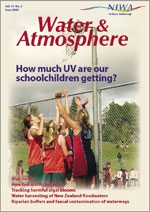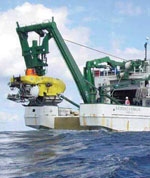PDF of this article (385 KB)

Down to the depths in a Yellow Submarine


In a joint US/NZ expedition, NIWA scientists spent April and May exploring the flanks of nine seamounts that form part of a chain running from the Bay of Plenty to Tonga. Using the deep-diving submersible Pisces V, they investigated hot vents and their associated fauna at depths as great as 1.6 km.
NIWA geologist Ian Wright and biologists Malcolm Clark, Ashley Rowden, and Alison MacDiarmid joined scientists from GNS, NOAA, and the University of Mississippi on-board the University of Hawaii’s research vessel Ka’imikai-o-Kanaloa (or KoK, for short). From there they used the submersible to study first-hand the geology, chemistry, and biology of hot, sulphur-rich vents. They found enormous populations of chemosynthetic bacteria forming thick white or orange mats. These sustain a dense population of specialised filter feeders, including mussels, goose barnacles, and tube worms. These in turn support a variety of predators, including lobsters, crabs, shrimps, starfish, and fish.
Vent macrofauna communities are of interest to biologists worldwide who wish to understand how these chemosynthetic-based systems function, and also how the diversity of isolated habitats in the marine environment is maintained. The little-studied vents of the Kermadec seamount chain are of particular interest because they are likely to be the connection between vent faunas of the eastern Pacific and the Indian and Atlantic Oceans.
For further information, contact: Dr Ian Wright, 0-4-386 0322, [email protected]
